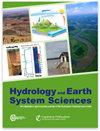Understanding the influence of “hot” models in climate impact studies: a hydrological perspective
IF 5.8
1区 地球科学
Q1 GEOSCIENCES, MULTIDISCIPLINARY
引用次数: 0
Abstract
Abstract. Efficient adaptation strategies to climate change require the estimation of future impacts and the uncertainty surrounding this estimation. Over- or underestimating future uncertainty may lead to maladaptation. Hydrological impact studies typically use a top-down approach in which multiple climate models are used to assess the uncertainty related to the climate model structure and climate sensitivity. Despite ongoing debate, impact modelers have typically embraced the concept of “model democracy”, in which each climate model is considered equally fit. The newer Coupled Model Intercomparison Project Phase 6 (CMIP6) simulations, with several models showing a climate sensitivity larger than that of Phase 5 (CMIP5) and larger than the likely range based on past climate information and understanding of planetary physics, have reignited the model democracy debate. Some have suggested that “hot” models be removed from impact studies to avoid skewing impact results toward unlikely futures. Indeed, the inclusion of these models in impact studies carries a significant risk of overestimating the impact of climate change. This large-sample study looks at the impact of removing hot models on the projections of future streamflow over 3107 North American catchments. More precisely, the variability in future projections of mean, high, and low flows is evaluated using an ensemble of 19 CMIP6 general circulation models (GCMs), 5 of which are deemed hot based on their global equilibrium climate sensitivity (ECS). The results show that the reduced ensemble of 14 climate models provides streamflow projections with reduced future variability for Canada, Alaska, the Southeast US, and along the Pacific coast. Elsewhere, the reduced ensemble has either no impact or results in increased variability in future streamflow, indicating that global outlier climate models do not necessarily provide regional outlier projections of future impacts. These results emphasize the delicate nature of climate model selection, especially based on global fitness metrics that may not be appropriate for local and regional assessments.理解 "热 "模型在气候影响研究中的影响:水文学视角
摘要要制定高效的气候变化适应战略,就必须估算未来的影响以及这种估算的不确定性。过高或过低估计未来的不确定性都可能导致适应不当。水文影响研究通常采用自上而下的方法,即使用多个气候模型来评估与气候模型结构和气候敏感性有关的不确定性。尽管争论不断,但影响模式研究者通常都接受 "模式民主 "的概念,即认为每个气候模式都同样适合。较新的耦合模式相互比较项目第 6 阶段(CMIP6)模拟显示,几个模式的气候敏感性大于第 5 阶段(CMIP5)的气候敏感性,也大于根据过去的气候信息和对行星物理的理解可能得出的范围,这再次引发了模式民主的争论。一些人建议将 "热门 "模型从影响研究中剔除,以避免影响结果向不可能的未来倾斜。事实上,在影响研究中纳入这些模型会带来高估气候变化影响的巨大风险。这项大样本研究考察了去除热点模型对北美 3107 个流域未来溪流预测的影响。更准确地说,该研究使用 19 个 CMIP6 全球环流模型(GCMs)的集合,评估了未来平均流量、高流量和低流量预测的变异性,其中 5 个模型根据其全球平衡气候敏感性(ECS)被认为是热点模型。结果表明,由 14 个气候模式组成的缩减集合提供了对加拿大、阿拉斯加、美国东南部和太平洋沿岸地区未来变异性降低的溪流预测。在其他地区,缩减后的集合要么没有影响,要么导致未来溪流变异性增加,这表明全球离群气候模型不一定能提供区域离群的未来影响预测。这些结果强调了气候模式选择的微妙性,尤其是基于全球适应性指标的选择,而这些指标可能并不适合地方和区域评估。
本文章由计算机程序翻译,如有差异,请以英文原文为准。
求助全文
约1分钟内获得全文
求助全文
来源期刊

Hydrology and Earth System Sciences
地学-地球科学综合
CiteScore
10.10
自引率
7.90%
发文量
273
审稿时长
15 months
期刊介绍:
Hydrology and Earth System Sciences (HESS) is a not-for-profit international two-stage open-access journal for the publication of original research in hydrology. HESS encourages and supports fundamental and applied research that advances the understanding of hydrological systems, their role in providing water for ecosystems and society, and the role of the water cycle in the functioning of the Earth system. A multi-disciplinary approach is encouraged that broadens the hydrological perspective and the advancement of hydrological science through integration with other cognate sciences and cross-fertilization across disciplinary boundaries.
 求助内容:
求助内容: 应助结果提醒方式:
应助结果提醒方式:


